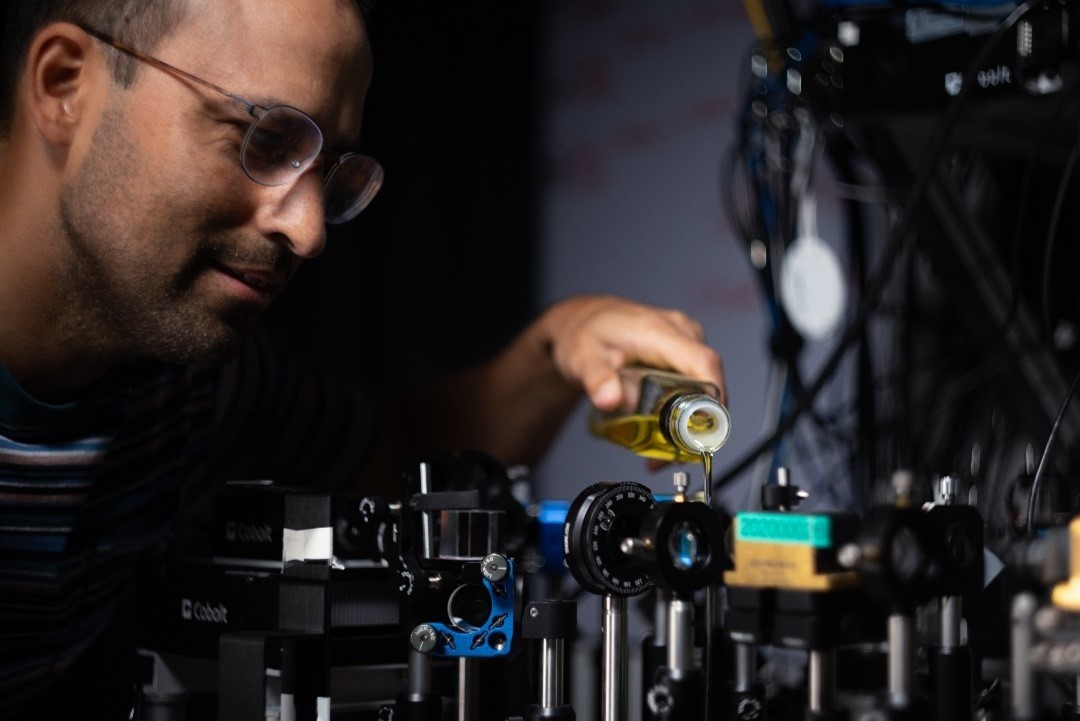AMOLF team breaks the symmetry in a metallic grating
Scientists at AMOLF and the University of Madrid have observed and described unique and spontaneous symmetry breaking in a metallic grating. By covering the grating with oil, they created a non-linear optical response with memory in the system. This resulted in asymmetric diffraction, even though the grating and illumination were symmetrical. Such behavior opens opportunities for better resolution in imaging and sensing methods with gratings. The scientists published their findings in Physical Review Letters on 27 September 2024.
It is a simple experiment that most physics students do during their studies: shooting a laser at a grating and observing the diffraction pattern. “Symmetry is what you will see,” says Said Rodriguez, head of the Interacting Photons group at AMOLF. “But we created a grating where the symmetry of the diffraction pattern can break spontaneously.”
Oil for nonlinear optics
The grating studied by the researchers displays a phenomenon known as bistability. This means that there are two possible outputs for the same input. In this case, the refractive index of a material covering the grating can have two different values for a given laser power. Consequently, two distinct diffraction patterns can be observed at a certain power. Which one is observed depends on whether the laser power is increasing or decreasing.
In the past, Rodriguez worked with metallic gratings and investigated bistability phenomena in optics. He wondered if he could combine these and create bistability in a metallic grating.
“When we did our first experiments with oil in optical cavities (see news item) we found several phenomena resulting from an interesting property of cinnamon oil: when the temperature rises, the refractive index of the oil changes, and at some point, the system becomes bi-stable,” he says. “When we put a drop of oil on top of a grating and illuminated it with a laser beam, interesting things happened immediately in the bistable regime.”

Multiple symmetries broken and restored
At low laser power, Rodriguez and his team saw a typical diffraction pattern with equal light intensity on both sides of the laser beam. But, when they increased the laser power and the oil got warmer, the symmetry of the diffraction pattern spontaneously disappeared and reappeared. This meant that several symmetries in the system broke down and restored spontaneously, even though the symmetry of the experiment had not been changed.
The periodicity of the grating was no longer translated to the resulting diffraction pattern and the mirror symmetry of the pattern was broken too; diffraction to the left and right side of the beam was no longer equally bright. And because the diffraction pattern was able to start oscillating randomly, time symmetry broke as well.

Theoretical basis
The researchers realized that the physical law of conservation of momentum no longer applied to their system. “This was a big claim to make, so we needed a thorough theoretical demonstration of our results,” says Rodriguez, who therefore asked his Spanish colleagues to develop the theory he would need to explain the findings. “This was not straightforward, because the methods in theoretical physics are based on symmetry and conservation laws, whereas we wanted to prove that these symmetries could be broken at the level of the well-established Maxwell’s equations.”
Even though the combined work of AMOLF and the University of Madrid reveals new insights in physics that are quite fundamental, Rodriguez sees possibilities to apply them in imaging and sensing. “Many techniques in spectroscopy, imaging and information processing are based on gratings,” he explains. “In a linear regime, gratings usually only respond at light coming from specific angles, but in this nonlinear regime, gratings can have a much richer angular response. Thus, you can measure across a much wider range of angles, and also resolve much smaller features with such an optical grating.”
Contact
Do you have questions related to this research? Then please contact Said Rodriguez
Reference
J. Abad-Arredondo, Z. Geng, G. Keijsers, F. Bijloo, F. J. García-Vidal, A. I. Fernández-Domínguez, and S. R. K. Rodriguez, Spontaneous Symmetry Breaking in Diffraction, Phys. Rev. Lett. 133, 133803, 27 September (2024).


